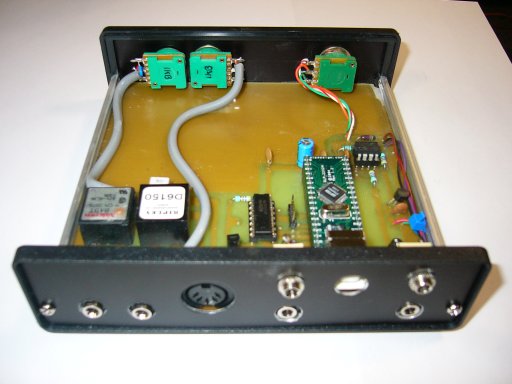| G3VGR | USB CI-V & Winkey Interface |
Now that modern PC's have either one or no Serial ports, one has to either use a collection of USB > Serial converters or find another solution to interface to the Icom CI-V bus. To my way of thinking, it doesn't seem too elegant to convert from USB to RS232 then to Icom's logic bus, so I wanted a more direct solution. Whilst surfing the web, I found FTDI's website. FTDI make USB > Serial interface chips and supply Virtual Comm Port (VCP) device drivers for Microsoft and Linux Operating Systems. Their DLP-2232M evaluation kit is an integrated module featuring their FT2232C Dual USB UART/FIFO. After reading the documentation, it appeared that the DLP-2232M was ideal for my application, so I ordered one from Mouser (part #626-DLP2232M). Unfortunately FTDI no longer supply this product. It has since been replaced by the DLP-2232M-G module.
I used one port to communicate with the Icom CI-V bus and buffered the DLP-232M's input/output pins with a 7417 Hex Buffer IC as recommended in the ARRL Handbook CI-V Interface design. I made the port's DTR & RTS outputs jumper selectable and used another of the 7417's buffers to drive some 2N3904s, providing a PTT function. As there was a second (spare) port available, I interfaced it directly to a Winkey IC. The Winkey IC (and also the 7417) are powered by +5v from the PC USB Bus, so the keyer is inoperable when the PC is powered off. This restriction is not an issue for me. I had a nice Lansing Instruments case available to house this project, and, as there was plenty of space available in the case, I included yet another simple soundcard interface. The box now provided three functions which reduces the shack clutter. The simple circuitry was built on a homemade PCB. The artwork was hand-drawn directly using a "Dalo" etch-resist pen. The rear view of the completed project is shown below. A schematic and pcb layout is available

Everything worked first-time as soon as I plugged in the USB cable. After Windows XP detected the new hardware, the FTDI serial port drivers were loaded and the 2 ports installed as COM3 (Winkey) and COM4 (CI-V). I use the CI-V interface with N1MM Logger and Logger32. The Winkey works fine with N1MM Logger and my own QD Keyer program.
When my family bought me a Begali paddle as a birthday present, I started to get some erratic keying of dots from the Winkey. This was a due to varying contact resistance on the paddles affecting the voltage detedtion on the PIC's input. This has been a common issue and Microham sold an inline debouncer to address the problem. I modified the circuit by adding 2 Scmitt inverters and FET switches as detailed by W9AC on the K1EL Keyers Yahoo Group